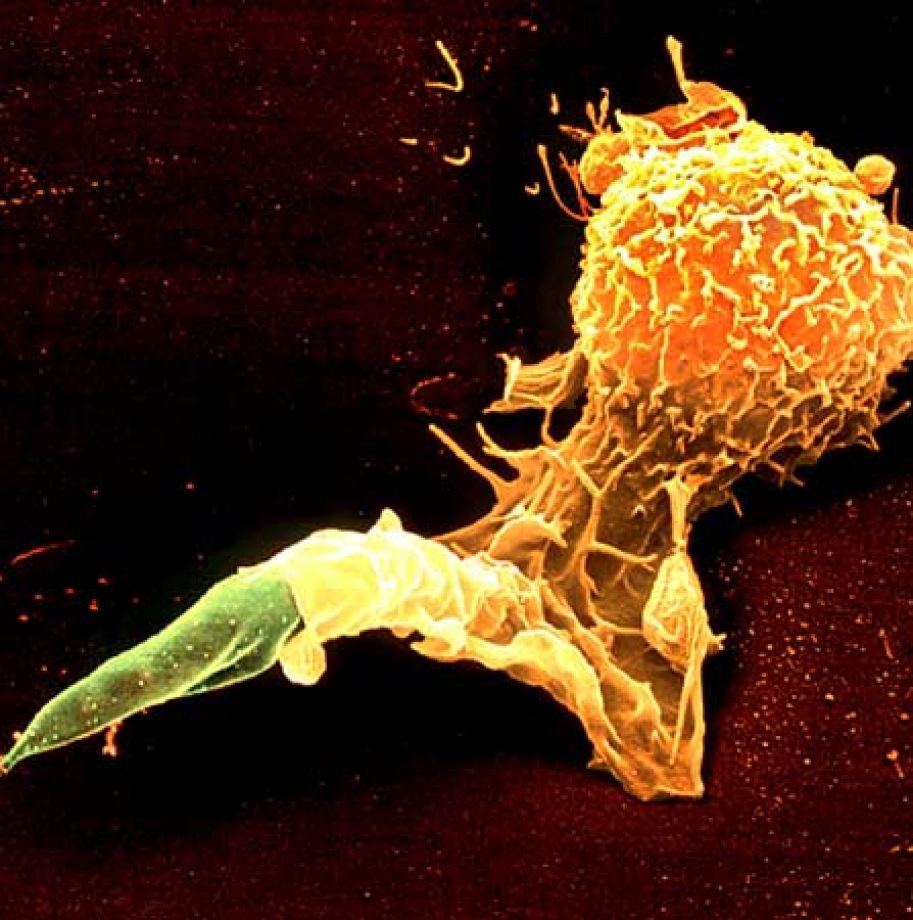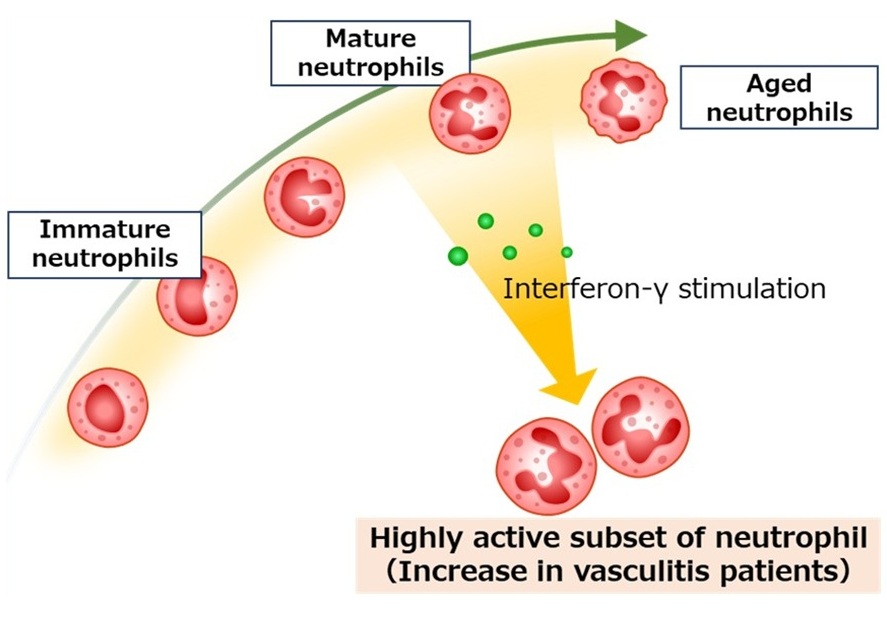Cytokine Release Assays Tests for Leishmaniasis in Transplant Recipients
|
By LabMedica International staff writers Posted on 09 Nov 2015 |

Image: Tissue smear from a patient infected with Leishmania infantum showing numerous protozoan bodies phagocytized by macrophages (Photo courtesy of Dr. Yutaka Tsutsumi).

Image: Colored scanning electron micrograph of a macrophage white blood cell engulfing a Leishmania promastigote (Photo courtesy of Juergen Berger).
Cytokine release assays have been used to determine the prevalence of Leishmania infantum infection in solid organ transplant (SOT) recipients living in an area where the organism is endemic following an outbreak.
Spain has one of the world’s largest pools of organ donors and is a global leader in terms of the number of transplants it performs but the current outbreak of leishmaniasis in Fuenlabrada in the southwest of the region of Madrid has involved 600 clinical cases since late 2009, a prevalence of 0.2%.
Scientists at the Instituto de Salud Carlos III (Madrid, Spain) enrolled 63 SOT (kidney, liver and heart) recipients who were aged 18 years or older, had undergone transplant surgery between 2005 and 2013, and resided in the town of Fuenlabrada. Fifty seven subjects had experienced no previous episode of visceral leishmaniasis (VL) or compatible symptomology (NVL subjects), and six had been cured of visceral leishmaniasis (CVL subjects).
Leishmania infantum antigen extract was prepared from promastigote stationary phase parasite cultures. Peripheral blood mononuclear cells (PBMCs) were isolated by density centrifugation and the collected cells were cultured in RPMI 1640. Cell proliferation was measured by bromodeoxyuridine incorporation using the Cell Proliferation Biotrak ELISA kit (General Electric Healthcare Life Sciences, Little Chalfont, UK). The supernatants of the in vitro cell cultures were collected and stored at -20 °C for cytokine quantification. Cytometric quantification was carried out using BD Cytometric Bead Array Human Flex Set and data were acquired using a FACSCalibur flow cytometer (Becton Dickinson Biosciences, Franklin Lakes, NJ, USA).
Seventeen subjects (12 NVL and 5 CVL) showed a patent lymphoproliferative response to soluble Leishmania antigen (SLA). Stimulation of peripheral blood mononuclear cell cultures and of whole blood with SLA led to the production of different combinations of cytokines that might serve to confirm Leishmania infection or recovery from VL and help prevent cured patients from relapsing into this serious condition. The results showed that tests for the cell–mediated immune response are crucial for detecting exposure to L. infantum as serological tests alone are insufficient. This is especially true when trying to detect evidence of exposure in immunosuppressed individuals, who are at greater risk of developing clinical leishmaniasis after becoming infected or relapsing after treatment for VL.
The authors concluded that their results highlighted the need to use tests that detect the cell-mediated immune response when screening for asymptomatic subjects in areas with endemic leishmaniasis. They also show that PBMC cultures and/or whole blood assays can be used to search for leukocyte cytokine production as a marker of infection. The production of IFN-γ, TNF-α, granzyme B, IL-5 and IL-10 by SLA-stimulated PBMCs, and of IFN-γ, TNF-α and IL-2 by SLA-stimulated whole blood, could be used to indicate exposure to leishmaniasis, especially for patients subjected to induced immunosuppression. The study was published on October 23, 2015, in the journal Public Library of Science Neglected Tropical Diseases.
Related Links:
Instituto de Salud Carlos III
General Electric Healthcare Life Sciences
Becton Dickinson Biosciences
Spain has one of the world’s largest pools of organ donors and is a global leader in terms of the number of transplants it performs but the current outbreak of leishmaniasis in Fuenlabrada in the southwest of the region of Madrid has involved 600 clinical cases since late 2009, a prevalence of 0.2%.
Scientists at the Instituto de Salud Carlos III (Madrid, Spain) enrolled 63 SOT (kidney, liver and heart) recipients who were aged 18 years or older, had undergone transplant surgery between 2005 and 2013, and resided in the town of Fuenlabrada. Fifty seven subjects had experienced no previous episode of visceral leishmaniasis (VL) or compatible symptomology (NVL subjects), and six had been cured of visceral leishmaniasis (CVL subjects).
Leishmania infantum antigen extract was prepared from promastigote stationary phase parasite cultures. Peripheral blood mononuclear cells (PBMCs) were isolated by density centrifugation and the collected cells were cultured in RPMI 1640. Cell proliferation was measured by bromodeoxyuridine incorporation using the Cell Proliferation Biotrak ELISA kit (General Electric Healthcare Life Sciences, Little Chalfont, UK). The supernatants of the in vitro cell cultures were collected and stored at -20 °C for cytokine quantification. Cytometric quantification was carried out using BD Cytometric Bead Array Human Flex Set and data were acquired using a FACSCalibur flow cytometer (Becton Dickinson Biosciences, Franklin Lakes, NJ, USA).
Seventeen subjects (12 NVL and 5 CVL) showed a patent lymphoproliferative response to soluble Leishmania antigen (SLA). Stimulation of peripheral blood mononuclear cell cultures and of whole blood with SLA led to the production of different combinations of cytokines that might serve to confirm Leishmania infection or recovery from VL and help prevent cured patients from relapsing into this serious condition. The results showed that tests for the cell–mediated immune response are crucial for detecting exposure to L. infantum as serological tests alone are insufficient. This is especially true when trying to detect evidence of exposure in immunosuppressed individuals, who are at greater risk of developing clinical leishmaniasis after becoming infected or relapsing after treatment for VL.
The authors concluded that their results highlighted the need to use tests that detect the cell-mediated immune response when screening for asymptomatic subjects in areas with endemic leishmaniasis. They also show that PBMC cultures and/or whole blood assays can be used to search for leukocyte cytokine production as a marker of infection. The production of IFN-γ, TNF-α, granzyme B, IL-5 and IL-10 by SLA-stimulated PBMCs, and of IFN-γ, TNF-α and IL-2 by SLA-stimulated whole blood, could be used to indicate exposure to leishmaniasis, especially for patients subjected to induced immunosuppression. The study was published on October 23, 2015, in the journal Public Library of Science Neglected Tropical Diseases.
Related Links:
Instituto de Salud Carlos III
General Electric Healthcare Life Sciences
Becton Dickinson Biosciences
Latest Immunology News
- Stem Cell Test Predicts Treatment Outcome for Patients with Platinum-Resistant Ovarian Cancer
- Machine Learning-Enabled Blood Test Predicts Immunotherapy Response in Lymphoma Patients
- Post-Treatment Blood Test Could Inform Future Cancer Therapy Decisions
- Cerebrospinal Fluid Test Predicts Dangerous Side Effect of Cancer Treatment
- New Test Measures Preterm Infant Immunity Using Only Two Drops of Blood
- Simple Blood Test Could Help Choose Better Treatments for Patients with Recurrent Endometrial Cancer
- Novel Analytical Method Tracks Progression of Autoimmune Diseases
- 3D Bioprinted Gastric Cancer Model Uses Patient-Derived Tissue Fragments to Predict Drug Response
- Blood Test for Fungal Infections Could End Invasive Tissue Biopsies
- Cutting-Edge Microscopy Technology Enables Tailored Rheumatology Therapies
- New Discovery in Blood Immune Cells Paves Way for Parkinson's Disease Diagnostic Test
- AI Tool Uses Routine Blood Tests to Predict Immunotherapy Response for Various Cancers
- Blood Test Can Predict How Long Vaccine Immunity Will Last
- Microfluidic Chip-Based Device to Measure Viral Immunity
Channels
Clinical Chemistry
view channel
‘Brilliantly Luminous’ Nanoscale Chemical Tool to Improve Disease Detection
Thousands of commercially available glowing molecules known as fluorophores are commonly used in medical imaging, disease detection, biomarker tagging, and chemical analysis. They are also integral in... Read more
Low-Cost Portable Screening Test to Transform Kidney Disease Detection
Millions of individuals suffer from kidney disease, which often remains undiagnosed until it has reached a critical stage. This silent epidemic not only diminishes the quality of life for those affected... Read more
New Method Uses Pulsed Infrared Light to Find Cancer's 'Fingerprints' In Blood Plasma
Cancer diagnoses have traditionally relied on invasive or time-consuming procedures like tissue biopsies. Now, new research published in ACS Central Science introduces a method that utilizes pulsed infrared... Read moreMolecular Diagnostics
view channel
Revolutionary Blood Test Detects 30 Different Types of Cancers with 98% Accuracy
With cancer expected to become the leading cause of global mortality by 2030, early detection remains the most effective strategy to reduce death rates. Current screening methods only cover five types... Read more
Simple Blood Test Better Predicts Heart Disease Risk
Cardiovascular diseases (CVDs) are the primary cause of death worldwide. A large proportion of these cases could be prevented by addressing lifestyle and environmental factors such as smoking, poor diet,... Read moreHematology
view channel
New Scoring System Predicts Risk of Developing Cancer from Common Blood Disorder
Clonal cytopenia of undetermined significance (CCUS) is a blood disorder commonly found in older adults, characterized by mutations in blood cells and a low blood count, but without any obvious cause or... Read more
Non-Invasive Prenatal Test for Fetal RhD Status Demonstrates 100% Accuracy
In the United States, approximately 15% of pregnant individuals are RhD-negative. However, in about 40% of these cases, the fetus is also RhD-negative, making the administration of RhoGAM unnecessary.... Read moreMicrobiology
view channel
Handheld Device Delivers Low-Cost TB Results in Less Than One Hour
Tuberculosis (TB) remains the deadliest infectious disease globally, affecting an estimated 10 million people annually. In 2021, about 4.2 million TB cases went undiagnosed or unreported, mainly due to... Read more
New AI-Based Method Improves Diagnosis of Drug-Resistant Infections
Drug-resistant infections, particularly those caused by deadly bacteria like tuberculosis and staphylococcus, are rapidly emerging as a global health emergency. These infections are more difficult to treat,... Read more
Breakthrough Diagnostic Technology Identifies Bacterial Infections with Almost 100% Accuracy within Three Hours
Rapid and precise identification of pathogenic microbes in patient samples is essential for the effective treatment of acute infectious diseases, such as sepsis. The fluorescence in situ hybridization... Read morePathology
view channel
Sensitive and Specific DUB Enzyme Assay Kits Require Minimal Setup Without Substrate Preparation
Ubiquitination and deubiquitination are two important physiological processes in the ubiquitin-proteasome system, responsible for protein degradation in cells. Deubiquitinating (DUB) enzymes contain around... Read more
World’s First AI Model for Thyroid Cancer Diagnosis Achieves Over 90% Accuracy
Thyroid cancer is one of the most common cancers worldwide, and its precise management typically relies on two primary systems: (1) the 8th edition of the American Joint Committee on Cancer (AJCC) or ... Read more
Breakthrough Diagnostic Approach to Significantly Improve TB Detection
Tuberculosis (TB) remains the deadliest infectious disease globally, with 10.8 million new cases and 1.25 million deaths reported in 2023. Early detection through effective screening is crucial in identifying... Read more
Rapid, Ultra-Sensitive, PCR-Free Detection Method Makes Genetic Analysis More Accessible
Genetic testing has been an important method for detecting infectious diseases, diagnosing early-stage cancer, ensuring food safety, and analyzing environmental DNA. For a long time, polymerase chain reaction... Read moreTechnology
view channel
Disposable Microchip Technology Could Selectively Detect HIV in Whole Blood Samples
As of the end of 2023, approximately 40 million people globally were living with HIV, and around 630,000 individuals died from AIDS-related illnesses that same year. Despite a substantial decline in deaths... Read more
Pain-On-A-Chip Microfluidic Device Determines Types of Chronic Pain from Blood Samples
Chronic pain is a widespread condition that remains difficult to manage, and existing clinical methods for its treatment rely largely on self-reporting, which can be subjective and especially problematic... Read more
Innovative, Label-Free Ratiometric Fluorosensor Enables More Sensitive Viral RNA Detection
Viruses present a major global health risk, as demonstrated by recent pandemics, making early detection and identification essential for preventing new outbreaks. While traditional detection methods are... Read moreIndustry
view channel
Cepheid and Oxford Nanopore Technologies Partner on Advancing Automated Sequencing-Based Solutions
Cepheid (Sunnyvale, CA, USA), a leading molecular diagnostics company, and Oxford Nanopore Technologies (Oxford, UK), the company behind a new generation of sequencing-based molecular analysis technologies,... Read more
Grifols and Tecan’s IBL Collaborate on Advanced Biomarker Panels
Grifols (Barcelona, Spain), one of the world’s leading producers of plasma-derived medicines and innovative diagnostic solutions, is expanding its offer in clinical diagnostics through a strategic partnership... Read more



















